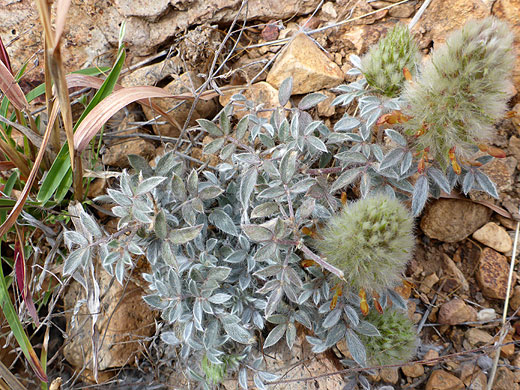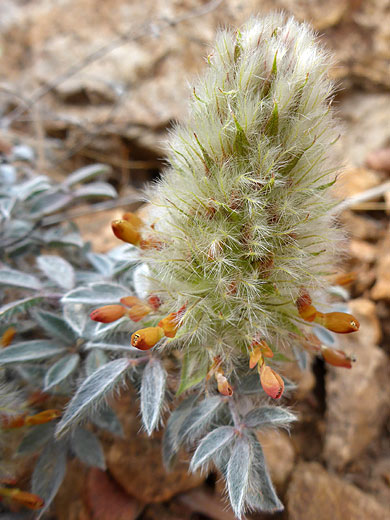
Elongated, silky hairy inflorescence - dalea wrightii along the Upper Burro Mesa Pouroff Trail in Big Bend National Park, Texas
Common name:
Wright's prairie clover
Family:
Scientific name:
Dalea wrightii
Main flower color:
Range:
South Arizona, south New Mexico and west/south Texas
Height:
Up to 12 inches
Habitat:
Grassland, washes, open flats; 3,000 to 5,000 feet
Leaves:
Pinnately divided into hairy, lanceolate to ovate leaflets, less than half an inch long
Season:
April to October
Most parts of dalea wrightii are covered by long, soft, white hairs; both sides of the grey green leaflets, the short stems, the floral bracts and the bristly, lobed calyces. Plants produce several stems, from a woody caudex, generally ascending or erect. Leaves have a terminal leaflet and one to three pairs of opposite side leaflets; all are pointed at the tip and tapering at the base. Leaflets are dotted with small glands.
The inflorescence is a dense, elongated cluster, of flowers and bracts, these about a third of an inch long, narrowly lanceolate and pointed at the tip. Bracts are green, reddish at the apex, and have a few glands along the edges. Flowers open in stages, from the base of the cluster to the top; all petals are yellow, sometimes tinged with purple, and they become red as they wither.
The inflorescence is a dense, elongated cluster, of flowers and bracts, these about a third of an inch long, narrowly lanceolate and pointed at the tip. Bracts are green, reddish at the apex, and have a few glands along the edges. Flowers open in stages, from the base of the cluster to the top; all petals are yellow, sometimes tinged with purple, and they become red as they wither.
All Contents © Copyright The American Southwest | Comments and Questions | Contribute | Site Map



